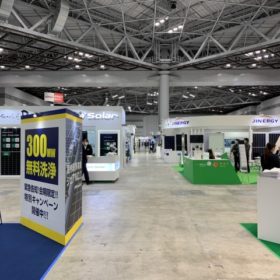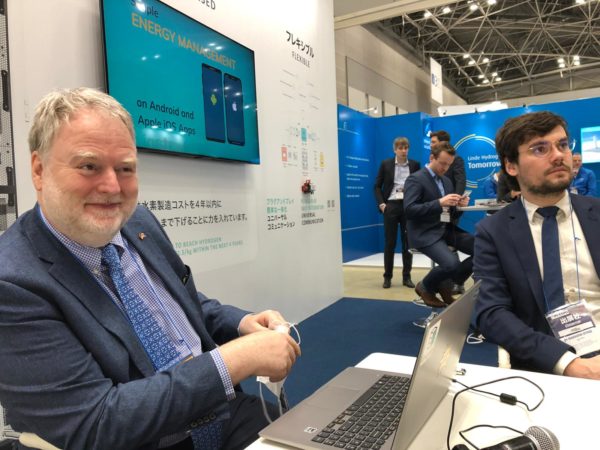
The annual trade show was not particularly well-attended this year, but market sentiment is still positive in Japan – nobody believes that installations will drop due to the coronavirus outbreak. And the country's upstream industry – modules, batteries, and hydrogen tech – clearly remains compelling, given the number of brave souls who actually did make the trip out to Tokyo Big Sight this year.
Those who did show up to PV Expo in Tokyo this week were greeted by infrared cameras and were kindly told to put on face masks, only to find a largely empty trade show floor, as coronavirus fears prompted many industry participants to take a pass on Japan’s leading energy exhibition this year.
It was an unfortunate situation for exhibitors, organizers, and stakeholders in Japan’s renewables business, because 2020 could be another 7 GW to 7.5 GW year in terms of annual installations, according to RTS Corp., a Tokyo-based research outfit.
On Tuesday, the day before the show, the Japanese Cabinet held a press conference outlining the government’s plan to build a more resilient national power system. Weeks-long power outages in Hokkaido and Chiba prefecture have forced politicians to draw up a disaster resilience plan.
“We are aiming to establish a resilient and sustainable electricity supply system in view of the intensification of disasters that has changed the energy environment,” Minister of Economy, Trade and Industry Hiroshi Kajiyama said.
The government endorses the value of distributed solar+storage. Additionally, the cabinet has tabled a bill regarding the feed-in premium, which is set to replace the feed-in tariff. To date, electricity companies are being forced to buy solar power at rates set by the FIT, which has been worryingly expensive. The country holds the world record when it comes to end-user power prices.
In response to this, Japan has started to hold competitive tender rounds with undisclosed ceiling prices for utility-scale PV projects. The fifth round was designed to allocate 416 MW of capacity, but ended up only awarding 27 projects with a cumulative capacity of 39.8 MW. With the feed-in premium, solar plant owners would receive a premium on current market prices to refinance their assets, but the government has yet to determine the exact details so they can be signed off by parliament. Japan’s political elites aim to get it done by April 22, but overall the plan appeared to be welcomed on the trade show floor.
Dominik Grützner, representative director of mounting system supplier S-Rack, said that there are enough projects that have been developed and tendered over the last few rounds to keep the industry bustling for a while. But RTS Corp. claims that utility-scale PV projects in Japan actually have a low commissioning rate of just 35%. Of the 21.9 GW of approved projects above 2 MW in size, just 7.2 GW have actually been commissioned to date.
Empty booths
The hall for PV suppliers at PV Expo was particularly empty this week, as exhibitors from China mostly decided to skip out on the annual show. This meant that PV Expo 2020 did not provide the first glimpse of new module tech that will be rolled out this year, as expected. That’s unfortunate, as Japan’s New Energy and Industrial Technology Development Organization (NEDO) has managed to produce a 30x30cm perovskite module with an efficiency rating of 16.09%. That said, Japanese PV module heavyweights such as Panasonic and Sharp stayed clear of the trade show floor this year, anyway.
There were some developments in terms of products at the show, with Trina Solar announcing a 500 W bifacial module, for example. Beyond that, Japanese conglomerate Marubeni had a number of big announcements to make this week related to the acquisition of Taiwanese solar developer Chenya Energy. However, it didn’t get the chance to share the news at the show, as its booth was completely empty.
On the inverter side, Sungrow showed up with an AC-coupled solution, the ST159KWH-50HV, as well as a DC-coupled offering: the ST751KWH-D350+SG49K5J for C&I-scale containerized storage. The devices come in three-hour versions, as the company claims that under current C&I solar market conditions in Japan, such systems are the most economically viable option.
Sungrow introduced the product to the Japanese market in 2019 and has already sold about 30 MW. The Chinese inverter manufacturer is now targeting the C&I storage retrofitting market, which it sees as particularly promising. It also offers a Japan-licensed version of its 100 kW string inverter. In addition, Sungrow currently has a 5 kW inverter in the licensing process on the residential side. Once cleared, the company hopes to capture about 10% of the traditionally hard-to-access Japanese market.
The company also appears close to finalizing a 100 MW supply deal with Japan’s GS Yuasa. The agreement involves PV and storage solutions alike and could provide a significant boost for the company’s business in the country. Thus far, Sungrow has supplied about 50 MWh of storage in Japan, and it has been involved in a few single-digit, megawatt-scale landmark projects throughout the archipelago.
Current health concerns aside, PV Expo is part of a group show – World Smart Energy Week – that includes a Battery Expo and Fuel Cell Expo. The latter two were somewhat better attended, with more exhibitors in the halls. The reason could be that visitors and exhibitors from Europe and North America attended in greater numbers than their Chinese counterparts. Of course, the PV industry – especially the manufacturing business – relies heavily on Chinese suppliers, as the empty booths at PV Expo show.
But the higher attendance at the other parts of the show can also be attributed to the fact that Japan has a very strong hydrogen and battery sector. The country currently hosts a significant amount of residential hydrogen capacity and a potpourri of companies from all over the world have come to join the party.

Image: pv magazine
One of those companies is Enapter, which showcased a modular electrolyzer approach in Tokyo this week. The device uses a new method in the electrolyzer process known as REM. The technology makes the device smaller and more efficient, and the hydrogen product more pure than rival PEM technology, which is the most widely used option at the moment.
Enapter says its electrolyzer can produce 1 cubic meter of hydrogen at 4.4 kWh. Sebastian-Justus Schmidt, the founder of the company, put the future into perspective. “Japan’s Ministry of Economy, Trade and Industry issued a hydrogen strategy by which it wants to achieve 1 cubic meter of hydrogen production at 4.3 kWh by 2030. So we are 10 years ahead, so to speak,” he said.
Despite the unusual circumstances at this year’s PV Expo, spirits were high on the trade show floor and analysts expect the Japanese market to continue to flourish. In short, the relative lack of exhibitors and visitors at the show this year largely came down to health-related concerns, and did not reflect market sentiment.
Lắp đặt điện mặt trời Khải Minh Tech
https://ift.tt/2X7bF6x
0906633505
info.khaiminhtech@gmail.com
80/39 Trần Quang Diệu, Phường 14, Quận 3
Lắp đặt điện mặt trời Khải Minh Tech
https://ift.tt/2ZH4TRU
Không có nhận xét nào:
Đăng nhận xét